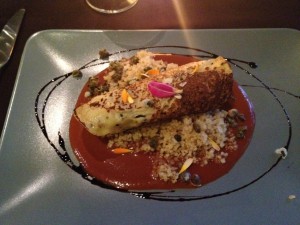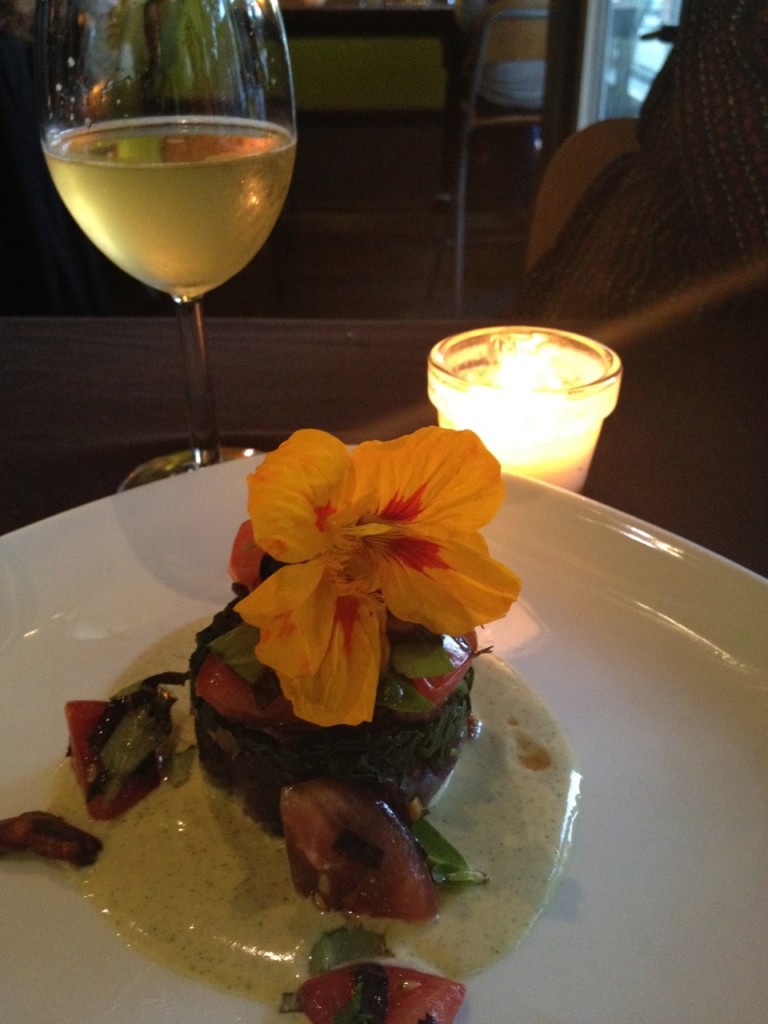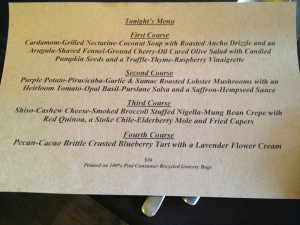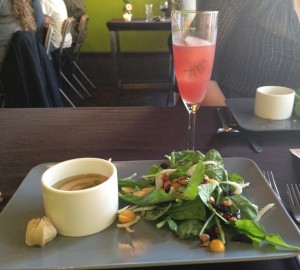My friend Sandy is really into food and animal welfare, and over the past year or so, she has moved from a vegetarian to a vegan diet. The impact on my life includes trips to amazing vegan restaurants that I didn’t know existed, like Araya‘s in Bellevue, which specializes in vegan Thai food. She picked out another winner last night, Sutra, which does a single sitting for dinner three nights a week, and just two seatings on weekends. It serves a prix-fixe menu that changes every couple weeks. I’ll get to the specifics on the amazing meal in a second.
What prompted me to write tonight isn’t the restaurant — I make no bones that I’m not a food reviewer by trade — but the conversation Sandy, her friend Darcy, and I had about making the decision to forgo meat, fish, and other animal products. I get why people do it. The factory farming that provides us with cheap chicken and plastic wrapped meat isn’t designed to be kind to animals, and it certainly doesn’t show the world any close-up view of where our food comes from. I don’t eat any meat that comes from traditional intensive farms. I buy it occasionally, from producers my local co-op, PCC makes sure treat their animals humanely. In an ideal world, I’d get meat and chicken — which I eat an average of maybe once a week — from farms that raise a few animals in a farm (not business) environment and humanely slaughter them on site.
Dairy producers aren’t better on a large scale. Male offspring of dairy cows and goats are usually sold on and slaughtered, often immediately after birth. There is little or no bonding or natural mothering between mother and calf or kid. I’d love to get my milk and cheese from a neighbor with a cow. But I don’t, and I like milk in my tea and cheese too much to give it up. I think about it though. I don’t have a problem with eggs personally because I get them from a friend who has about 100 chickens, geese and ducks, all with names. Sharon knows which animal is pecking at her shoes by sight, and she doesn’t light the hen house so her chickens lay only when it’s egg season (determined by the amount of light the chickens get; ducks and geese don’t lay year round as a rule). She has some hens who are more than a dozen years old and still lay eggs. Every animal should be raised like Sharon raises her chooks.
The problem is that we don’t have access to the kind of protein our families ate a couple hundred years ago when most lived an agrarian life, when meat was a treat, a condiment that wasn’t the centerpiece of everyday meals. The problem is that even if we had that access to that kind of food, most people wouldn’t be able to afford it, and if they could wouldn’t want to pay for it. And I don’t think most people want to eat something that had a name and was part of some child’s family for years. I also believe that if most people saw the way their food was produced, from birth to slaughter, they’d stop eating meat.
The cool thing about having a committed philosophical vegan as a friend — as opposed to people I know who don’t eat meat for health reasons or because they don’t like it — is that I get to explore restaurants and menu options that I wouldn’t otherwise know about.
Sandy emailed me yesterday morning, telling me there was a chair left at Sutra’s seating, did I want to join her and Darcy? Why not? Wednesday is traditionally Girls’ Night Out for me and my friends. The menu was amazing enough that we took a picture of it.
The first course of grilled nectarine soup and a salad didn’t thrill me, mostly because I wanted to taste more of the nectarine in the soup and the salad was dressed with truffle oil and I’m apparently weird because I don’t like truffles unless they’re made of chocolate, preferably dark.
Each course came with an optional pairing of wine or non-alcoholic beverages (we chose the latter) such as a tart cherry goji berry and thyme elixir (above), CommuniTea’s on tap kombucha, which tasted like a hard cider or a very light, sweet wine with a little fizz (second course), or another fruit and herb infused drink.
The second course was the standout (that’s why I put it at the top of the post): a timbale of purple potatoes, lobster mushrooms and white Russian kale (substituting for the piracicaba) on a delicious bed of hemp-seed gravy. I could have eaten that stuff with a spoon by the bowlful. One of the owners said it’s one of the items that makes devoted meat eaters sit up and take notice. I can see why. The hemp seeds add the mouth feel commonly associated with butter or cream.
 A mung-bean crepe filled with smoked broccoli, a fermented cashew “cheese”, and covered with a spicy mole followed, and the meal ended with a dessert of a crispy-crusted blueberry tart with coconut cream. Both were amazing, but I don’t think they could hold a candle to that second course.
A mung-bean crepe filled with smoked broccoli, a fermented cashew “cheese”, and covered with a spicy mole followed, and the meal ended with a dessert of a crispy-crusted blueberry tart with coconut cream. Both were amazing, but I don’t think they could hold a candle to that second course.
 When I was young, I was a committed vegetarian for 20 years or so. It ended when I got pregnant and suddenly had to eat meat. My dad used to make fun of the foods that are often eaten by vegetarians, saving the most strident fun-poking for this lentil loaf I used to make (which was really pretty good, Dad!).
When I was young, I was a committed vegetarian for 20 years or so. It ended when I got pregnant and suddenly had to eat meat. My dad used to make fun of the foods that are often eaten by vegetarians, saving the most strident fun-poking for this lentil loaf I used to make (which was really pretty good, Dad!).
I know my dad’s taste buds pretty well, and I bet he’d like some of what we ate tonight. I’d bet just about anyone would. And although the USDA was scared into dropping the suggestion that people eat less meat, I’ll take up the mantle. And if all those beef farmers who objected had the chance to eat like this daily, I bet they’d eat less meat, too.

















Great write up on Sutra and their amazing food! What a great night!!
Lentils are also commonly used in Ethiopia in a stew-like dish called kik, or kik wot, one of the dishes people eat with Ethiopia’s national food, injera flat bread. Yellow lentils are used to make a nonspicy stew, which is one of the first solid foods Ethiopian women feed their babies.`”‘,
http://caramoan.coCheck out the newest post at our new blog